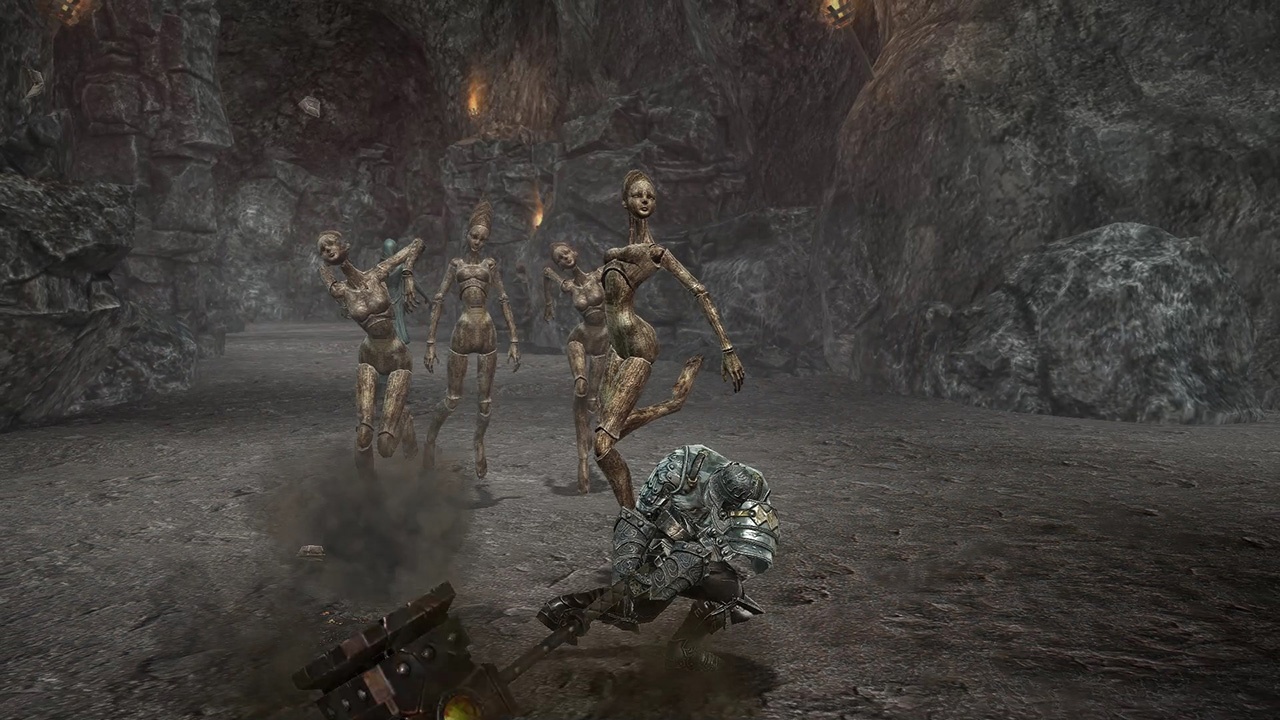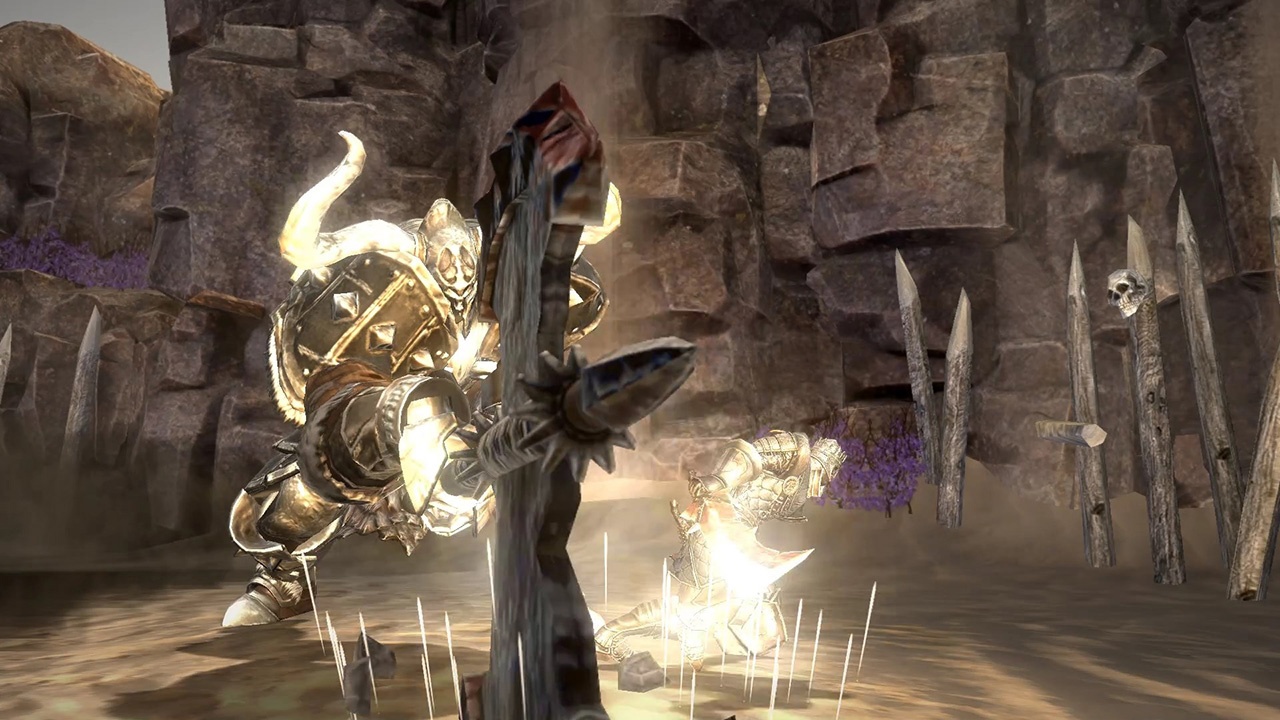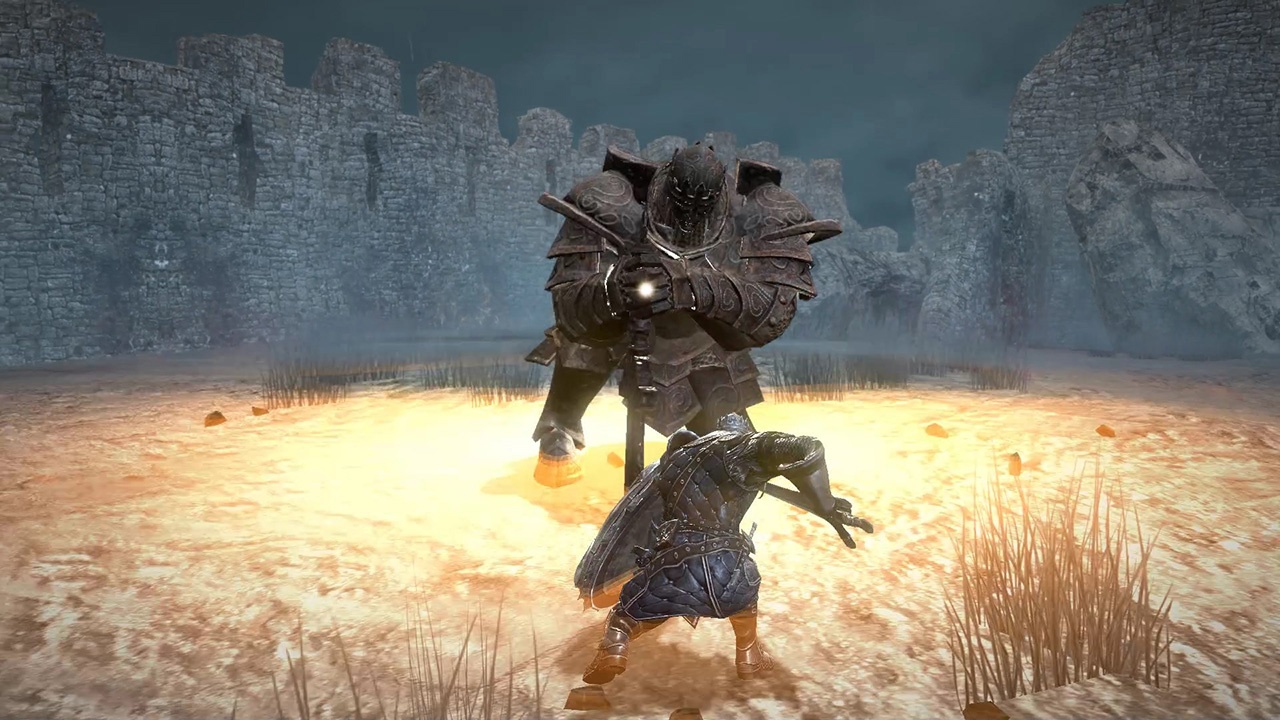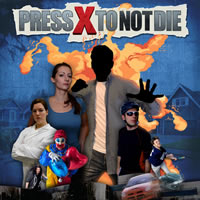 I don’t like comparing games to Dark Souls, as a rule. I’ve written elsewhere that using ‘X is the Dark Souls of Y‘ is, while perhaps a useful shorthand, often an oversimple and lazy way of describing whatever X happens to be, which is almost certainly something different from Dark Souls and worth judging on its own merits rather than simply pointing out which of its elements are and aren’t similar to FromSoftware’s revered genre-definer.
I don’t like comparing games to Dark Souls, as a rule. I’ve written elsewhere that using ‘X is the Dark Souls of Y‘ is, while perhaps a useful shorthand, often an oversimple and lazy way of describing whatever X happens to be, which is almost certainly something different from Dark Souls and worth judging on its own merits rather than simply pointing out which of its elements are and aren’t similar to FromSoftware’s revered genre-definer.
That said, there’s no point trying to talk about ANIMUS without talking about Dark Souls, because ANIMUS is so clearly and explicitly trying to evoke in the mind of the player the thought of that rage-quittiest of action RPGs. It’s got stamina-based combat involving light and heavy attacks, dodge rolls, shield blocking, backstabs, stagger and poise mechanics, limited healing items and even the ability to summon spectral warriors to your aid. It’s got little swords, long spears, bigger swords, fancy shields, extremely big swords – all with their own movesets – and a selection of light and heavy armours. There’s a grim-fantasy opening cutscene in which a female voice calmly narrates an opaque history, culminating in gods challenging each other and wreaking catastrophe on humanity, at the end of which a lone warrior walks forth. There’s a big, musclebound blacksmith chap with a lovely bushy beard, and a female guide who wears a red hooded cloak. Oh, and it’s got bosses.
All of these are elements ANIMUS shares with our revered friend, but I firmly believe that a work can be inspired by another – even so clearly that it might be called derivative – and still be a worthwhile experience, especially if the whole adds up to a different sum of the parts. Unfortunately, ANIMUS opts to present itself in both visuals and gameplay as being as similar to Dark Souls as it can manage, and that makes it really difficult to judge on its own merits. It’s impossible not to go ‘ah, this is like Souls but not quite as good’: when even From’s own other works (Bloodborne, Sekiro) owe much to Dark Souls but present themselves as new, different experiences to be enjoyed as separate and distinct entities, something that tries so very hard to feel as Souls-y as possible is really hard to take on its own terms. It’s set the terms, and the terms are Souls.
And ANIMUS – this may come as a shock, so brace yourself – isn’t as good as Dark Souls.
Now that we’ve got that elephant out of the room, I’m going to try to do the rest of the review without mentioning Souls. Just know that if you spot ANIMUS and think (as you might well do since, again, everything about its visual presentation is so similar that it cannot possibly be anything other than extremely deliberate) that it looks a bit Souls-ish and might be worth picking up as a sort of Souls-lite, something to scratch that itch… well, you’ll probably enjoy it for a bit before realising that you may as well just play Souls. (Side note: ANIMUS looks and feels probably a bit more like Demon’s Souls than Dark Souls, in fact, but somehow I get the impression that the latter’s success is specifically what the imitation was based on.) So that’s the short version for those wondering how it stacks up to its ancestor apparent; with that – onwards to pastures not-FromSoft-related!
What is ANIMUS (other than… that which will no longer be mentioned)? It’s an action RPG which is, as best as I can tell, a standalone Switch version of a mobile game (which I’ve not played, so can’t comment on how similar or dissimilar it might be). It’s described on the Nintendo eShop as a ‘mythology-based hardcore action’ game which is ‘very tactical’ and will ‘brutally punish any gamer expecting casual battles’, and I would say that most of that description feels reflected in the design of the game, whether the execution pulls it off well or not. I certainly recognise that there is a mythology to ANIMUS, but having spent a fair amount of time with the game now, there’s been very little development of that mythology beyond the aforementioned opening cutscene and a few vague allusions which aren’t really fleshed out. You can get a sense of a large, dark fantasy world through the variety of enemies, through some armour and weapon descriptions, and through dialogue from Lethe (your fair lady guide in this grim universe), but it’s not cohered into a real story, just some waving at people who lived in the past and whose names don’t mean much to you.

As for ‘hardcore action’ game, I’m of two minds. On the one hand, it bears the clear hallmarks of its mobile-game ancestry: levels are short (there’s even an estimated time given at level select, telling you how long it ought to take, and they’re usually suggested to be under five minutes and even less in practice), and there are limited-use ‘revive’ items that feel very much like a carryover from a pay-to-win structure. These things feel ‘casual’, in the sense of being able to pick up the game for short stretches at a time and put it down pretty much whenever. On the other hand, I don’t think that meaning of the word ‘casual’ is the antonym for ‘hardcore’ as it’s being used here (although the two terms are often in opposition): I think the ‘hardcore’ here is more to do with the game’s difficulty, and I can agree that it is punishing.
Each level in ANIMUS consists of a brief run (through generally lacklustre and unmemorable terrain, sad to say) killing enemies – who do have to be killed, as the path will be blocked by an invisible wall until all opponents are felled and so trying to sneak past is useless – and finally reaching a boss. Credit where credit’s due: almost all enemies, bosses included, are visually distinctive and well-designed. That’s a bonus on two counts: appealing design is always a plus in and of itself, and easily-recognised foes means you can plan your attack before engaging, already having learned their movesets. Even regular foes are, indeed, pretty punishing for the beginner; they’re often quicker than you, hard-hitting, and able to attack at different ranges, but bosses can be real life-loss-aloozas. It took me a while to work out that ANIMUS does in fact do something different here: it’s important to learn the attacks of each boss, the better to punish openings and, y’know, avoid dying, but perhaps even more important is adjusting your gear to match the boss you’re facing.
At this point, I get to make some comparisons to non-From games! Huzzah!
In some games (BUT I’LL NEVER SAY WHICH ONES), the player can pick their playstyle or ‘build’ to suit the way they like approaching combat, then make all the relevant gameplay choices based on that initial decision and be able to play the whole rest of the game that way. Fan of magic? Cool: you put your growth points into the appropriate stats, pick magical equipment, and then you use your magical character’s magical tactics until you’ve achieved ultimate victory and all is well. Enjoy tanking heavy sloggers? Sweet: make sure to sink a ton of points into stamina and HP, don super-heavy armour and a giant shield, and then just go forth and conquer.
In others, you need a bit more flexible of an approach: think Monster Hunter, which requires that you adapt your equipment and style to suit the mark, or Horizon Zero Dawn‘s emphasis on matching weapon strengths to machine weaknesses. Or, like, Pokémon, in an example I think speaks for itself. I wasn’t expecting this to be the case in ANIMUS (thanks at least in part to my preconceptions about the sort of game it was going to be; your mileage will doubtless vary as to whether this instance of expectation-subversion is a cool twist or a confusing genre-mess-up). Between levels, you can change your equipment to arm yourself with a range of weapons, from quick-hitting bladed gloves to ludicrously huge greatswords, and each weapon has its own set of elemental attributes – same sort of thing applies to armour and resistances. This is critical to success in ANIMUS: you’re really unlikely to get far, even if you’re fantastic at these sorts of games (which I’m not), unless you spend quite a while trying different loadouts on bosses to identify their weaknesses.
There’s character progression via levelling up, of course – which grants you points to allocate to stats including poise, dodge range, HP, all the standards – and equipment progression via the blacksmith. You’re encouraged to grind at particular levels in order to accumulate a) full sets of new types of weapon and armour with associated Useful Attributes, b) ‘shards’, which are basically currency exclusively for upgrading gear, and c) duplicates of weapons and armour you already have, so that you can sell them or have them taken apart for shards. I think it’s fair to say that grinding is a required and focal element of ANIMUS‘s gameplay cycle and user experience, which is perhaps another hearkening back to its mobile origins and perhaps a way of stressing themes of long struggle, of growth, of cycles. (There’s another game that has themes like that, I’m sure of it!)

Overall, it’s not a terribly dissatisfying experience, actually. There’s a bit of a slog to farm for the right equipment, and a bit of frustration in spending time bashing big ol’ swords up against bosses only to realise that this is not in fact the big ol’ sword with the specs you need, but coming back with the right equipment and finally overcoming the feller who’d been repeatedly smashing your face into the ground with a perturbingly sturdy hammer is pretty enjoyable.
There are also a couple of combat elements which are, while not huge innovations, little details that add a bit of depth. There’s the fact that enemies, in addition to the HP bars above them, also have visible meters indicating how close they are to being staggered or knocked back; this adds some short-term tactical thinking to how you place your blows and how frequently. You’ve got a super-attack of sorts which charges up during battle, to be triggered later when needed; it can either unleash one big hit or initiate a brief power state during which time all your hits carry more weight. The stamina system is overall pretty well-done: a deliberate slow pace, a thoughtfulness, is developed in the player. The game encourages you to try out all of your weapons’ movesets through giving combo button prompts at the bottom of the screen, the successful execution of which delivers a powerful hit and begins to build up a ‘Devastate’ gauge to unleash more hell upon your unfortunate foes.
Unfortunately, the inclusion of the onscreen button prompts – while it is nice having an opportunity to discover all the combos available to you – serves to highlight that the controls are sometimes pernickety. Your inputs can buffer occasionally in a way that throws off timing, so you’ll find yourself mashing the buttons in an attempt to ensure the game recognises what you’re asking it to do… and, in doing so, quite possibly end up unleashing several blows in a row that weren’t the ones you were going for. The attention-grabbing prompts also draw attention to the fact that there isn’t much else in the way of instruction: you can look at a list of controls from the settings menu, but that doesn’t really tell you how to play, and occasional vague hints will pop up at the top of the screen during gameplay seemingly apropos of nothing and unrelated to whatever you happen to be doing at that moment. It’s not too hard to pick up the basics of combat, but it really is up to the player to work out for themselves that the macro-gameplay elements (which is to say the cycle of boss->farming->upgrades->boss) are more complex than simply throwing themselves at the same problem with the same equipment and hoping to get somewhere.
Despite my observing that ANIMUS is imperfect in many ways, not helped by its exposing itself to unfavourable comparison, I think there’s a not insignificant cohort of gamers for whom it’ll be an experience they might be looking for, and which they might enjoy pretty well. There’s a lot to like about it, even if most of those things range from really-not-as-good to marginally-less-good when compared to other things out there (like, y’know, a certain 2011 ARPG): combat is, at its best, a satisfying and fulfilling triumph over conflicts, and the loop of working to further your character progression and develop your equipment to match your foe feels like a well-enough-executed take on those RPG elements.
For the price point, ANIMUS represents decent value for money as a meeting of the casual and the hardcore, an experience you can dip in and out of and play whenever and wherever but which does deliver gameplay that usually manages to stay on the enjoyable side of brutal and punishing.
REVIEW CODE: A complimentary Nintendo Switch code was provided to Bonus Stage for this review. Please send all review code enquiries to press@4gn.co.uk.
Subscribe to our mailing list
Get the latest game reviews, news, features, and more straight to your inbox
Thank you for subscribing to Bonus Stage.
Something went wrong.
ANIMUS Review
-
Gameplay - 6/10
6/10
-
Graphics - 6/10
6/10
-
Sound - 5/10
5/10
-
Replay Value - 3/10
3/10
User Review
( votes)Overall
Summary
ANIMUS is a well-put-together, if derivative, ARPG worth picking up for on-the-go Switch gameplay.






